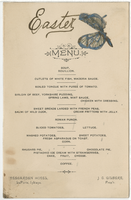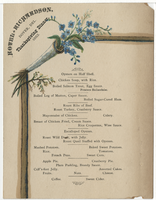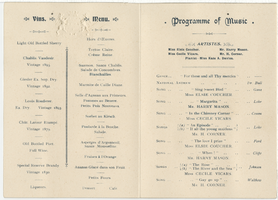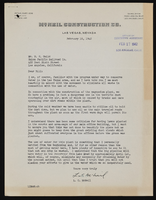Search the Special Collections and Archives Portal
Search Results

Film strip of individuals or Hoover Dam construction, image 003: photographic print
Date
1930 (year approximate) to 1939 (year approximate)
Archival Collection
Description
This photograph has three images. The first one, (0272_0020) reads, "Personal pictures taken by Tommy Teas (my brother-in-law) of his work mates on #8 line. Bucket swinging, hard to spot. It hanging about 500 ft. Bell boy talking to operator who is out of sight on top of mountain," as a handwritten inscription. The second one (0272_0021) reads "Men building key, about 10 in. high and two ft. wide. (1) Bell boy getting a good sight to spot the bucket in the right place," as a handwritten inscription. The third one (0272_0022) is an upside down picture of the Dam. Its handmade inscription reads, "Still below river bed. Good look at a pouring crew (x) shows bell boy giving orders to operator. Nice shot showing how bucket works. After the bucket leaves, the men will walk all through the fresh mud to walk out any air pockets."
Image

Film strip of individuals or Hoover Dam construction, image 005: photographic print
Date
1930 (year approximate) to 1939 (year approximate)
Archival Collection
Description
This photograph has two images. The first one (0272_0038) reads, "No.7 hi-line 'My first job'. Showing all the old crew. I am seasoned by now. But Colette the boss (bottom right), on my first night, began to eat me out because I didn't know to follow the crew to next pour. Here stood a man as large as a bull, with a black eye and a hare-lip & bull-dog face, didn't fear me at all - all my fear was on that stuff going back and forth overhead." The second one (0272_0039) has an inscription that reads, "Good view of men working on No.8 hi-line - not up to the intake towers yet, but have dumped a lot of mud in this hole - good picture for night shift. A good action picture. Know all the men well - First there is Slim, Blackie, the man whose back we see is Whitie, the foreman then Tommie. My brother-in-law. There are four lines like this."
Image

Film strip of individuals or Hoover Dam construction, image 008: photographic print
Date
1935-03
Archival Collection
Description
This photograph has three images. The first one (0272_0069) says, "'Nevada spillway' during overflow from a record snowfall in the mountains. Reeves fell from the entrance, shown behind the head caption reads: 'Tourists photographing spillway at Hoover Dam; tunnel behind man's head carries runoff almost half a mile to the Colorado River below.'" The second image (0272_0070) shows a young dam worker, R.B. Reaves (friend of John Kizziar), with the information that Reaves fell to his death in the Colorado River. "He lost his balance while working in the Nevada spillway raise. He was only 17 years old. He was a form stripper for Six Companies, March 1935." The third image (0272_0071) shows a view looking upstream through the channel of the Arizona spillway, Boulder Dam. It reads," Spillway with gates up. Weight of water will open gates. Working platform is being moved out of tunnel."
Image

Film strip of individuals or Hoover Dam construction, image 009: photographic print
Date
1930 (year approximate) to 1939 (year approximate)
Archival Collection
Description
This photograph has three images. The first one (0272_0072) is upside-down, and it reads, "Speaking of celebrities - 'Form Raising Crew'. A tough and dangerous - a few boys were hurt on this one. I managed to say a little prayer before climbing over a hanging, swinging panel - Dear 'God' don't let it fall now. Only one man on it while it's swinging. Get that first bolt in fast. Art Strickland 'Ill'. Swinging panels make him seasick - some chickens can't fly." The second one (0272_0073) has a handwritten inscription that reads, "'Form Raising Crew' (cont.) 'So. Dakota Slim' - My Gott in himmel! If we had something that wouldn't move - we called on Slim and Reeves." The third one (0272_0074) shows a general view of operations looking across Black Canyon from high point above Nevada spillway. It reads, "Birds eye view of dam, spillways, -- intake towers."
Image

Film strip of individuals or Hoover Dam construction, image 010: photographic print
Date
1930 (year approximate) to 1939 (year approximate)
Archival Collection
Description
This photograph has three images. The first one (0272_0075) reads,"'Form Raising Crew,' 'Chris' the Boss - Webfoot 'Oregon' - Alright boys; let's go over the top - Reeve and I had the guts to climb over a swinging panel. If it was a large panel Slim would climb over after we secured it with a bolt on each end." The second image (0272_0076) reads, "'Form Raising Crew' - Pal Jake 'Georgia' - Georgia Cracker. ([Georgia as in:] 'Whar's the hammah? Who's got the bahr')." The third one (0272_0077) shows a particular day on site a week after Reeve's seventeenth birthday themed "something for the kid." The inscription reads, "The Crew. This form is hooked up to 'A' frame bars you see in foreground, is used to pry form from cement after it has been unbolted. Then it is jacked up to position and bolted up. Then load your 'A' frame - jacks, and block & tackle, and move to another job - some high pours have four panels - all swinging."
Image

Teegarden Hotel Easter menu
Date
1870 to 1933
Archival Collection
Description
Note: No date on menu Restaurant: Teegarden Hotel Location: La Porte, Indiana, United States
Text

Thanksgiving dinner menu, 1883, at Hotel Richardson
Date
1905-02-25
Archival Collection
Description
Note: Color illustration Restaurant: Hotel Richardson Location: Dover, Delaware, United States
Text
Pagination
Refine my results
Content Type
Creator or Contributor
Subject
Archival Collection
Digital Project
Resource Type
Year
Material Type
Place
Language
Records Classification


